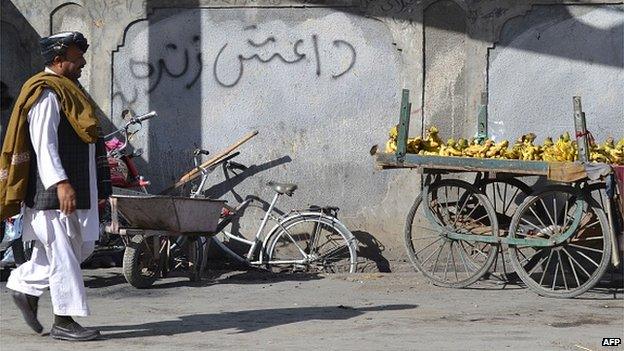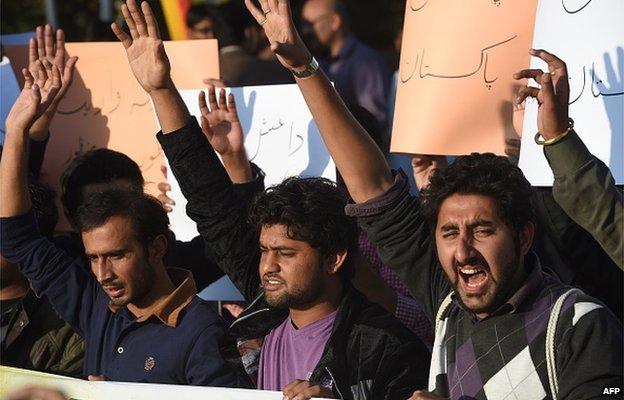Islamic State enters fray in Pakistan
- Published

Islamic State, whose Arabic acronym Daesh is seen here in Quetta, has been making inroads in Pakistan
Islamic State drew first blood against Pakistan at the weekend when its regional spokesman claimed their fighters had shot dead three Pakistani soldiers.
But how big an advantage does this represent for the group?
Few are willing to speculate.
Most analysts see IS as a phenomenon of the Levant, having no roots in South Asia.
Recent claims by some sub-groups within the Taliban to having joined IS are seen by many as reflective of their loss of clout and funding due to a Pakistani military operation that ended their sanctuaries in the north-west of the country.
IS has taken nearly six months since its inception in this region to launch its first attack. And it chose a rather easy target.
In mid-October, six former militants associated with the Pakistani Taliban, the TTP, announced they were quitting the group and had vowed their allegiance to IS leader Abu Bakr al-Baghdadi.
The only figure known to the outside world among these six was Shahidullah Shahid, a long time spokesman of the TTP.
And the only tangible loss to the TTP - as confided by a top TTP leader to a credible source - was that of its commander for the Orakzai region, Saeed Khan.
Although largely unknown until he was named by Shahidullah Shahid, Mr Khan's significance is understandable.
Orakzai straddles a mountain range with passes providing access into several adjoining regions such as the Kohat valley to the south, Afghanistan's Nangarhar province to the north-west, and the strategically important Peshawar valley to the north-east.
The region spawned the first version of the Pakistani Taliban way back in the late 1990s, known mainly for their raids on music stores across large parts of the south of what is now Khyber Pakhtunkhwa (formerly North-West Frontier Province).
Post-9/11, Orakzai became of pivotal significance for anti-Pakistan groups seeking to exert pressure on Peshawar, and on the road linking it with the Afghan capital Kabul, a major supply route for Western troops stationed there.

Fears in Pakistan over Islamic State making inroads have prompted anti-IS rallies
Saeed Khan held important positions in Orakzai under the founder chief of the TTP, Baitullah Mehsud, first as head of the Taliban's Orakzai justice system and later as its operational head.
Under his watch, the Taliban inflicted maximum damage on Western military supplies passing through Peshawar, and brought the city itself close to administrative collapse during 2009-10.
But the rugged and inhospitable terrain of Orakzai does not support the kind of mainstream militancy that was made possible by the availability of easier, friendlier and strategically more advantageous regions like Wana and Miranshah in Waziristan.
However, in the wake of the Pakistani military offensive in Miranshah that started last June, areas like Orakzai can serve as fairly long-term hideouts for smaller numbers of militants.
And this is what many believe was in evidence last Saturday. A group of snipers attacked an army convoy heading from the garrison in Kohat to the upper Orakzai area of Ghaljo, killing three soldiers.
The most spectacular aspect of the attack was IS's claim of responsibility.
Analysts say the fact that the regional head of the IS took six months to launch a rather unimpressive attack on his own remote home ground indicates problems of funding and logistics.
Many say the IS is too preoccupied with Iraq and Syria to commit any significant funds and other resources to what they call Khorasan - a historical region comprising Afghanistan and parts of Central Asia, Iran, Pakistan and India, of which Saeed Khan has been appointed head.
But some official circles in Pakistan admit that IS could emerge as a greater threat to the country than it presently is.
They point to continued defections among the ranks of the Pakistani Taliban, the latest coming as recently as Monday when the new TTP spokesman, Mohammad Khorasani, told reporters their head and deputy head for Bajaur tribal region had stepped down.
The duo - Maulana Abu Bakar and his deputy, Qari Zahid - have not publicly spoken, but many speculate that they may be planning to join IS.
The IS threat in South Asia may be growing, but few believe it can get any worse than its various predecessors - unless state structures in Afghanistan, Pakistan or India show signs of a collapse, like they did in Iraq and Syria.